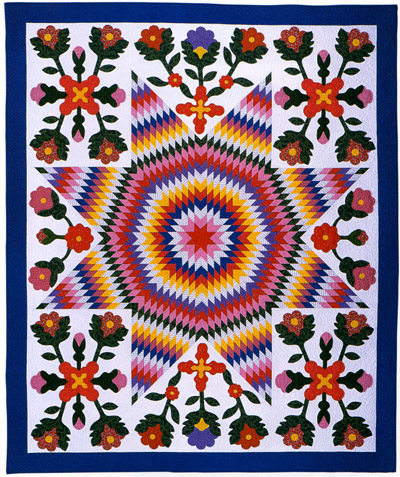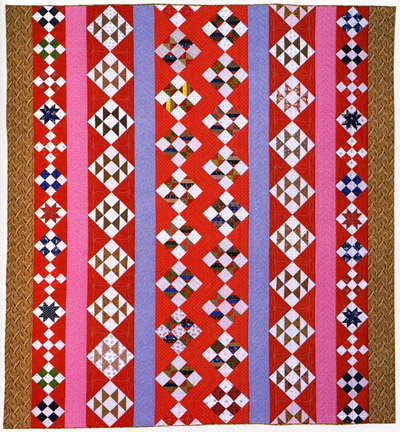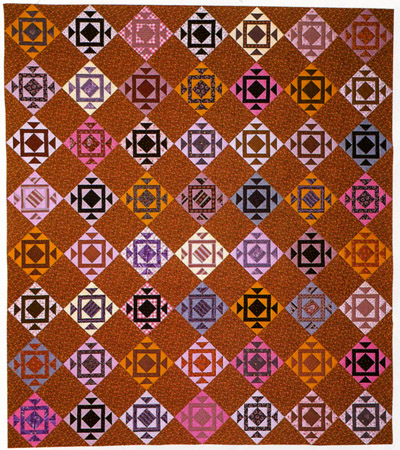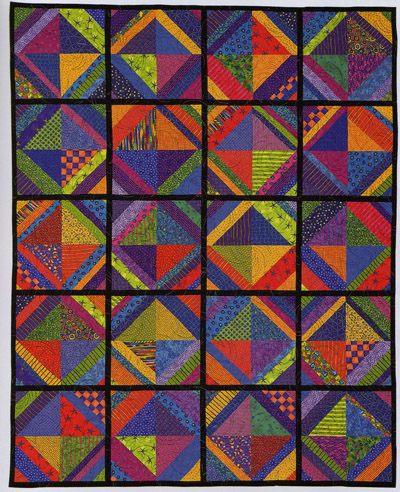BACK TO EXHIBITS
Quilts Old and New: Reproductions from the Great Lakes Quilt Center
Quilters have long used quilts created by their forebears as sources of inspiration for designs and as textbooks for learning about techniques, fabrics, and styles. Today, fabric and pattern manufacturers are frequently issuing products that reproduce those previously out-of-print, thus making it even easier for quilters to make quilts that copy older work.
The new quilts, designed and patterned by MSU Museum staff members Mary Worrall and Beth Donaldson, were selected to appeal to quilters of all skill levels.
These quilts were published, along with patterns and how-to-instructions, in Great Lakes, Great Quilts: Quilts from the MSU Museum Collections (Lafayette, CA: C&T Publishing, 2001). The two artists faithfully reproduced the older quilts and reinterpreted quilts from the more recent past. All twelve reproductions were shown side by side with the original quilts that inspired them from the museum’s collection. Great Lakes, Great Quilts describes the development of the quilt collections and the Great Lakes Quilt Center at the Michigan State University Museum and profiles discrete collections (Mary Schafer Quilt and Ephemera Collection, Clarke Family Quilt Collection, Merry and Albert Silber Collection, Kitty Clark Cole Collection, North American and Native Hawaiian Quilt Collection, Michigan African American Quilt Collection, and the Durkee-Blakeslee-Quarton-Hoard Family Quilt Collection). The book also includes patterns and instructions for reproducing the quilts in the museum's collections shown here.

Star of Bethlehem Quilt
Margaret (or Anna) David (Odawa)
c1920
Peshawbestwon, Leelanau County, Michigan
Collection of Michigan State University Museum acc.#6615.1
The original quilt is similar to several others made in the early 20th century by Native American women from Leelanau County, Michigan. It is probable that Native Americans began quilting in the Great Lakes region after the establishment of Catholic missions in the 19th century; it is known that quilting took place at the Immaculate Conception in Peshawbestown. According to James M. McClurken, co-author with James A. Clifton and George L. Cornell, of People of the Three Fires: The Ottawas, Potawatomi, and Ojibway of Michigan, the star and floral motifs used in this quilt are typical components of Ottawa (Odawa) designs and mimic designs depicted in earlier porcupine quill work and beaded pieces of the region.

Star of Bethlehem
Beth Donaldson, designer, machine piecer and machine appliquér; Kari Ruedisale, machine quilter
D2001
Lansing, Ingham County, Michigan
Collection of Michigan State University Museum acc.#TC2001:1
The reproduction of this traditional Lone Star is made easier by using rotary cutting and strip piecing techniques as well as machine piecing, appliquéing, and quilting. The fabrics of the original were calicos typical of the era and it is easy today to find similar reproductions. The appliqué shapes are all slightly different in the original. Irregularity in the shapes and placements of the Woodland flowers are part of this quilt’s original appeal and it is best not to be too exact when cutting, laying out, and sewing them in the reproduction.

Underground Railroad or Grandmother’s Fan Variation
Myla Perkins (b. 1939)
1984
Detroit, Wayne County, Michigan
Collection of Michigan State University Museum acc.#7421.1
The original quilt was made by Myla Perkins and her sister Clara Clark, along with Elva Gamble, Gwen Spears, and another set of sisters, Charlesetta Buie and Elizabeth Jaggers, the original members of the Detroit group, The Quilting Six Plus. Jaggers said that when the group first got together in the late 1900s, family and friends doubted that “six beautiful, intelligent black women were getting together to quilt.” When The Quilting Six Plus held their own exhibit and displayed more than 70 quilts, visitors were impressed and many asked to join the group. Myla Perkins named her variation of the Jacobs Ladder pattern the Underground Railroad quilt. Its name had nothing to do with the widely circulated but currently unsubstantiated story that certain quilt patterns were used as signs for travelers on the Underground Railroad.

Underground Railroad
Beth Donaldson, designer and piecer; John Putnam, machine quilter
2001
Lansing, Ingham County, Michigan
Collection of Michigan State University Museum acc.#TC2001:2
The design is a dynamic combination of plain blocks and pieced blocks in the Underground Railroad (also called Jacob’s Ladder) and Grandmother’s Fan patterns. The colors of the original quilt are soft and lovely and, since the original was made relatively recently, it is fairly easy to find fabrics to duplicate it. Beth thought it would be interesting to reverse the color palette in the reproduction. To show a scrappy approach as well, she placed her blocks of soft blues and a full range of yellow on a background of several different deep navies.

Rose in the Window
Maker unknown
c1860
Found in Michigan
Collection of Michigan State University Museum acc.#7610.1
The Museum staff determined that the original quilt was ca. 1860 date by an examination of the prints used in the sawtooths on each block. The combination of a simple appliqué surrounded by 60-degree triangles is unusual and the only one like it in the MSUM collection; it may be a completely unique pattern. Donor Merry Silber named the pattern Rose in the Window because the flowers are a typical Rose of Sharon pattern and the sawtooths framed each flower.

Rose in the Window
The MSU Museum Quilters
2000
Lansing, Ingham County, Michigan
Private Collection
This quilt was made by the MSU Museum Quilters for a raffle to raise funds to benefit the MSU Museum’s quilt collection. The MSU Museum quilters were a loosely organized group that, between 1999 and 2000, made 13 quilts for Safe House (the first domestic abuse shelter on a college campus) and this raffle quilt. Members of this group, led by Beth Donaldson, included Norine Antuck, Marge Dickinson, Nancy Bekofske, Geri Smith, Barb Worthington, Kate Edgar, Mary Edgar, Fran Tyndale, Ruby Post, Pat Clark, Carol Schon, Lennie Rathbun, Jackie Schulsky, Jane Roehm, Marie Van Tilburg, Peggy Bollaert, and Bonnie Bus. Donaldson drafted and gave the quilters the pattern for the quilt block and told them to use any fabric they thought looked old. It is always interesting to see how such a brief instruction on color can produce such terrific results. To make the quilt more appealing to ticket buyers, the quilt was made queen size by increasing the original number of blocks from 42 to 80. The scale of the blocks and sashings were unchanged.

String Plate
Ethel West Adair (1901-1993)
c1945
Oklahoma
Collection of Michigan State University Museum acc.#2000:1.1
Circular patterns like this one are known not only as Dresden Plate, but also as Wagon Wheel or Wheel of Fortune. The string piecing in the wheel spokes of this particular quilt, however, is unusual. Similar to crazy quilting, string piecing traditionally involves sewing pieces of fabric onto a fabric or paper foundation. The technique allows a quilter to make use of small or oddly shaped pieces of fabric which are not suitable for more regular patchwork. It more commonly appears in quilts as simple square blocks or as large eight-pointed stars.

String Plate
Mary Worrall, piecer and designer, Kari Ruedisale, machine quilter
2001
East Lansing, Ingham County, Michigan
Collection of Michigan State University Museum acc.#TC2001:4
The project for the String Plate Quilt was made in a palette similar to Ethel Adair’s original piece. The plates were pieced from the many reproductions of fabrics from the 1930s and 1940s which are available on today’s market. Brights or batiks against a black background fabric would be a fun alternative for piecing the quilt.

Bar Sampler
Maker unknown
c1890
Provenance unknown
Collection of Michigan State University Museum acc.#3694.1
Little is known about the provenance of the original quilt but, based on an examination of its fabrics, the museum staff estimates it to be ca. 1890. Even though the quilt is faded and has damage, it is an interesting example of the pattern because of the way in which the maker set the blocks on point, changed the scale of the blocks from the interior to the exterior strips, and used a zigzag setting in the center.

Bar Sampler
Beth Donaldson, designer; The Wednesday Group, machine piecers; Kari Ruedisale, machine quilter
2001
Lansing, Ingham County, Michigan
Collection of Michigan State University Museum acc.#TC2001:6
When quit samples are made for a book, the author/artist often relies heavily on friends to help out. Beth Donaldson took one look at the Bar Sampler and knew it was a perfect project for her pals, the Wednesday Group. The core remains strong with a shared fondness for “old-looking quilts.” Those who made this top are Pat Clark, Pat Linnell, Jackie Shulsky, Marie Van Tilburg, Carol Schon, Beth Donaldson, and Norine Antuck.
For this project, Beth tried to be as faithful as possible to the original colors used. In some cases, exposed seams made it easy for her to determine how much a color had faded, in other areas she had to guess. Beth enjoyed this project: “We found it fun to compare the reproduction with its crisp shirtings, double pink and soft blue strips, and strong red setting triangles to the well-used original. The quilt block in the center is also one that we couldn’t find documented in our sources. The closet we could come was a Jack Knife variation.”

Sawtooth
Top by Matilda Vary; finishing by Mary Schafer; quilting by Ida Pullman
Top dates to 1876, finished c1980
Top made in Ciresco, Calhoun County, Michigan
Collection of Michigan State University Museum acc.#1998:53.86
After she added a border and had the quilt finished, Mary Schafer signed the name of the top’s maker in ink on the quilt. A multitude of fabrics appear in the quilt, offering a study piece of fabrics from the last quarter of the 19th century. Mary’s paisley border is a typical print of a fabric available during the time she finished the quilt.

Sawtooth
Mary Worrall, piecer and designer; John Putnam, machine quilter
2001
East Lansing, Ingham County, Michigan
Collection of Michigan State University Museum acc.#TC2001:6

Fleur-de-Lis Album Quilt Top
Maker unknown
1855
Found in Battle Creek, Calhoun County, Michigan
Collection of Michigan State University Museum acc.#2000:58.1
According to information given to Julie Hacala, the original quilt top was previously acquired in the late 1990s from the estate of 107-year-old Mary Haley, an African-American who lived in Battle Creek, Michigan. However, subsequent research by the MSUM staff reveals that it is more probable that the quilt top was from the estate of Battle Creek resident Olga Haley who died at the age of 104. Her mother, Mary Haley, was born in Kent City, Michigan in 1837 and died in 1864.

Fleur-de-Lis Album Quilt
Members of the Capitol City Quilt Guild, hand appliquérs; Beth Donaldson, piecer and designer; Kari Ruedisale, machine quilter
2001
Lansing, Ingham County, Michigan
Collection of Michigan State University Museum acc.#TC2001:7
The Capitol City Quilt Guild was started in 1984, the same year as the Michigan Quilt Project inventory was launched. When the call went out for quilters to hand appliqué the blocks for this quilt on a tight deadline, these members of the guild took up the challenge: Marti Caterino, Pat Clark, Lennie Rathbun, Marie Van Tilburg, Beth Donaldson, Kate Edgar, Mary Edgar, Jackie Shulsky, Mary Hausauer, Nancy Johnston, Dorothy Jones, Jan Gagliano, Linda Kuhlman, Mary Hutchins, Phyllis O’Connor, Fran Mort, Carol Seamon, and Jan Quinn.

Fanny's Fan
Marguerite Gardner (b. 1878-1962)
c1930
Grand Rapids, Kent County, Michigan
Collection of Michigan State University Museum acc.#7438.3
Marguerite Moore, the maker of the original quilt and daughter of Zephiniah and Bernice Alice Taft Moore, was born in 1878. She graduated from Hillsdale College with a music degree and married Charles Vincent Gardner, a furniture maker, in 1905. Phyllis, their only child, believes her mother learned to quilt from her grandmother and that this is the only quilt that she made. Phyllis also remembers some of the dresses or blouses that were made of the same fabrics included in the quilt.

Fanny's Fan
Beth Donaldson, designer, piecer, and appliquér; John Putnam, machine quilter
2001
Lansing, Ingham County, Michigan
Collection of Michigan State University Museum acc.#TC2001:9
A classic adaptation of a classic pattern also known as Fanny’s Fan because of the scalloped edges of the fan blades. Reproduction fabrics currently available mixed with fabrics from Beth’s stash make a brightly colored quilt with a cheerful effect. Beth suggests that “you make sure and choose some fabrics that you wouldn’t think of as pastel to keep the palette from washing out. The original has many shades of black, brown, and red that are softened by the large amount of cream and pink fabrics used.”

Ducks In the Pond
Mary E. Beardslee Durkee
c1870
Birmingham, Oakland County, Michigan
Collection of Michigan State University Museum acc.#1999:12.6
Betty Quarton Hoard’s grandmother pieced this quilt with fabrics from the family store. Easily datable through the palette and prints found within, one can find the madders and purples common to the era. The family did not use the quilt, it remains a remarkable specimen whose colors remain true due to its lack of exposure to light.

Ducks in the Pond
Mary Worrall, designer; Kate Edgar, piecer; Kari Ruedisale, machine quilter
D2001
East Lansing, Ingham County, Michigan
Collection of Michigan State University Museum acc.#TC2001:10
Kate chose to pull from her stash of reproduction fabrics to create an even scrappier quilt than the pattern suggests.

String
Viney Crawford (b. 1912)
1986
Idlewild, Lake County, Michigan
Collection of Michigan State University Museum acc.#6520.1
Within the African-American community, Nine-Patch and Strip pattern quilts done in the String technique are most often cited by quilters as the first ones they learned and continue to prefer. Viney Crawford, of Idlewild, made this String quilt especially for the Michigan State University Museum in honor of the Yates Township Center in Idlewild. Idlewild, located in a rural area of Michigan’s lower peninsula, was developed in 1912 as a resort for the growing numbers of middle-class African-Americans. In its heyday, the resort hosted a who’s who list of African-Americans prominent in all walks of life and was destination for many of some of the nation’s most notable performers. An African-American Quilt Discovery Day was held in Idlewild in July, 1986.

String
Mary Worrall, piecer and designer; John Putnam, machine quilter
2000-2001
East Lansing, Ingham County, Michigan
Collection of Michigan State University Museum acc.#TC2001:11

Stove Eye
Mary Atkins
1987
Kalamazoo, Kalamazoo County, Michigan
Collection of Michigan State University Museum acc.#7132.1
Mary Atkins grew up in rural Arkansas and was about eight years old when she learned to quilt from her mother who made quilts for family use. According to Atkins, her mother taught her and her sisters to quilt in order to keep them out of mischief after they finished school or after doing their chores on the family farm. “There was no playing after work, but I’d sit down on a stool and begin piecing.” Mary Atkins even found inspiration for this design when she saw a bedcovering in a television advertisement for waterbeds. It is unknown why the quilter titles this “Stove Eye.”

Stove Eye
Mary Worrall, piecer and designer; Kari Ruedisale, machine quilter
2001
East Lansing, Ingham County, Michigan
Collection of Michigan State University Museum acc.#TC2001:12
The reproduction was made in a similar palette to the original. However, batiks were used rather than solids to create a greater texture within the quilt top.

Four Square Variation
Top by Elizabeth Samantha Fowler Weatherbee; finishing by Florence Vogt
Top dates to 1908, finishing 1969
Finished in Lansing, Ingham County, Michigan
Collection of Michigan State University Museum acc.#6581.2
The fabrics of this quilt are very typical of their era- a palette of wine red, navy, gray-blue, blacks, and shirtings. Simple patterns such as this four patch became very popular at the end of the 19th century. The top was made by Elizabeth Samantha Fowler Weatherbee who was born November 14, 1840. The quilt was made to commemorate the birth of her grandson, Benjamin E. Weatherbee. The top was later finished by Florence Vogt who embroidered “1903/1969” in its center.

Four Square Variation
Mary Worrall, piecer and designer; Barbara Worrall, piecer; Kari Ruedisale, machine quilter
2001
East Lansing, Ingham County, Michigan
Collection of Michigan State University Museum acc.#TC2001:8
With the many reproduction fabrics available, creating a reproduction of the Four Patch Variation was easy. Changing to bright colored fabrics would give the quilt a much different look. The simple shapes make this is a great quilt for beginners.

Brochure for the Great Lakes, Great Quilts fabric line
Collection of Michigan State University Museum

Brochure for the Trip Around the World fabric line.
Collection of Michigan State University Museum
Text by Mary Worrall and Beth Donaldson
-
Museum
Michigan State University Museum Michigan Quilt Project
-
Quiltmaker
Crawford, Viney Michigan African American Quilt Project
-
Quiltmaker
Atkins, Mary Michigan African American Quilt Project
-
Quiltmaker
Durkee, Mary Elizabeth Michigan Quilt Project
-
Author; Designer; Owner; Quiltmaker
Donaldson, Beth Michigan Quilt Project
-
Author; Creator; Interviewer; Quiltmaker
Worrall, Mary Michigan Quilt Project
-
Quiltmaker
Schafer, Mary Michigan Quilt Project
-
Ephemera
Great Lakes, Great Quilts
MacDowell, Marsha
-
Ephemera
Trip Around the World-Reproductions fr...
MacDowell, Marsha
-
Ephemera
Womenfolk 59. Underground Railroad/Jac...
Breneman, Judy Anne
-
c1870
Ducks in the Pond... Durkee, Mary Elizab...
-
2001
Duck's In the Pon... Edgar, Kate (Cather...
-
1958
Grandmother's Fan... Gardner, Marguerite...
-
2001
Fanny's Fan Repro... Donaldson, Beth
-
1876-1900
Bar Quilt Sampler... -
2001
Bar Quilt Sampler... Clark, Pat; Linnell...
-
1855
Fleur-de-lis Albu... -
2001
Fleur-de-lis Albu... Caterino, Marti; Cl...
-
1969
Four Patch Weatherbee, Elizabe...
-
2001
Four Patch Variat... Worrall, Mary
-
c1980
Sawtooth Vary, Matilda
-
2001
Sawtooth Reproduc... Worrall, Mary
-
1986
String Quilt Crawford, Viney
-
2001
String Quilt Repr... Worrall, Mary
-
ca 1920
Lone Star with fl... David, Anna
-
2001
Star of Bethlehem... Donaldson, Beth
-
1970
Stove Eye Atkins, Mary
-
2001
Stove Eye Reprodu... Worrall, Mary
-
1984
Underground Railr... Perkins, Myla
-
2001
Underground Railr... Donaldson, Beth
-
c1950
String Plate Adair, Nancy Ethel
-
2001
String Plate Repr... Worrall, Mary
-
ca 1860
Rose in the Windo... -
2000
Rose in the Windo... Antuck, Norine; Dic...
Load More